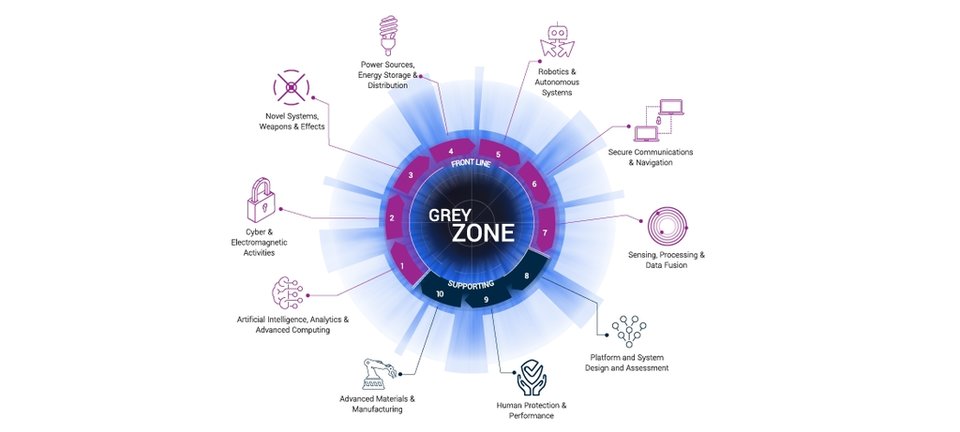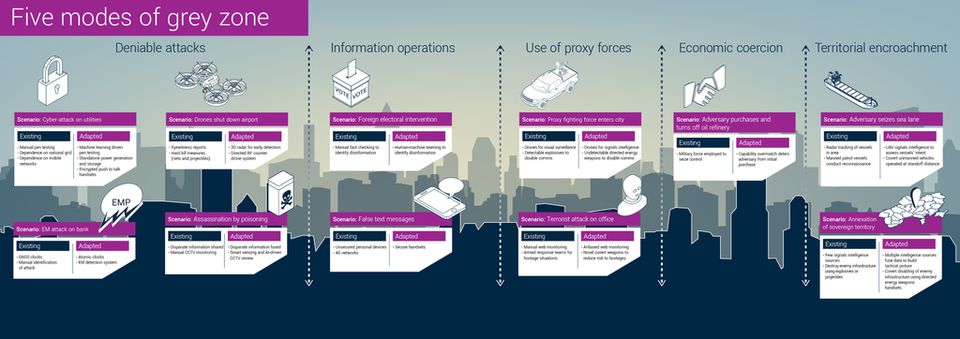Strategy
A level playing field: countering grey zone threats
Earlier this year, QinetiQ published a report exploring threats and opportunities presented by the ‘grey zone’ of conflict below the threshold of war. Harry Lye spoke to the company’s CTO Mike Sewart to learn more.
The grey zone is a concept that has gained increasing importance in recent years. It has come to the forefront of the UK’s discussions around defence and security as the country has moved forward with its Integrated Review into defence, security and foreign policy.
In the past, conflict was a reasonably straightforward construct, centered around two or more armed forces fighting directly on the battlefield. In the 21st century, the concept of conflict has become much more complex, with countries often operating below the threshold of traditional armed conflict to achieve their goals.
In recent memory, this has taken the form of the use of mercenary forces to complete military goals at arm’s reach, chemical weapons attacks on individuals, cyberattacks and subversion. All of these scenarios are addressed in QinetiQ’s report, titled ‘Confidence in chaos’, which was launched earlier this year.
Assessing the grey zone
“For many years, military power has ultimately arisen from large-scale capital budgets which are buying significant platforms,” says QinetiQ CTO Mike Sewart. “I think what we're alluding to now is that a few strokes on the keyboard can usually cause more havoc than firing a bullet. New skills are now going to be required to adapt to this new environment, and that includes software development, data scientists and all forms of other systems integration skills.
“They are perhaps not traditionally associated with the armed forces and are skills that are also in demand with other industry sectors. Those skills are going to be required going forward, along with a culture within the whole of defence-that is,industry plus defence departments – of being able to adapt to new ways of working and new technologies, in order to be able to be relevant in hybrid warfare.”
The critical takeaway of QinetiQ’s report is not that new hardware or large platforms need to be bought, or that investing solely in emerging science and technology will help Western governments tackle grey zone threats. Instead, the crux of the company’s argument is that emerging science and technology needs to be utilised to adapt and improve hardware to make it better suited to meet challenges in this field.

// Technology areas relevant to grey zone defence, according to QinetiQ.
The report outlines six common challenges the defence and security sector needs to overcome to better respond to grey zone tactics: creating information advantage, improving cyber resilience, improving threat detection, adding covert capabilities, adapting at pace and introducing new skills.
Detailing these challenges, Sewart explains: “I think that they are of equal concern and I would say that I don't think one is of more significant concern over the other. They are all reasonably weighted, but I also think they are all different.
“I think some of the newer technologies are also relevant to challenge four, which is covert capabilities. Challenges one, two and three are all about leveraging data and leveraging information to create an information advantage. Going forward, I think that's particularly complicated when you've got multiple assets, multiple sources of information coming in and it requires much more collaboration between all of the frontline commands, certainly in the UK context, to create a collective advantage.”
One part of countering grey zone threats is making better and more efficient use of the vast amounts of data and information available.
One part of countering grey zone threats is making betterand more efficient use of the vast amounts of data and information available. “Securely leveraging that data is absolutely part of dealing with grey zone tactics and ensuring the integrity of that data to ensure it hasn't been manipulated is critical,” Sewart says. “Once you've got the data, it's about making sense of it.
“I think that's where newer technologies in terms of machine learning can help to verify the authenticity of information, but also to augment and leverage the power of cloud computing to get rid of irrelevant information so that the operator or user has got absolutely the right information at the right time. That is important not to increase the cognitive burden and help decision making in the field.”

// This infographic from QinetiQ details five modes of grey zone tactics.
Hybrid warfare levels the playing field
Traditional power relations between states have been shaken up considerably by grey zone threats, as non-state actors and groups can cause significant disruption with limited means.
“I think the grey zone and hybrid warfare levels the playing field because a kid in a bedroom can cause quite a devastating effect on a critical national infrastructure asset –sometimes to a more significant impact than a military establishment could,” Sewart explains. “What I am illustrating here is that you don't need a lot of capital to cause chaos through the manipulation of information, or leveraging of software, and for cyberattacks.”
While a general who has spent years learning tactics and doctrine may have one idea of how to disrupt a critical national infrastructure site, a grey zone actor may take a completely different approach that could be even more effective and wholly unexpected.
However, grey zone threats do not exist in a silo and have not replaced armed conflict entirely. As recent events in Nagorno-Karabach have shown, armed conflict is still very relevant. Another example is Russia, which has a portfolio of grey zone tactics in its arsenal but is still investing heavily in traditional military hardware such as tanks and missiles.
There is no doubt that the critical mass of our forces is significant to combating threats; however, I think we also need to ensure that we are investing in the skills and technologies needed to combat grey zone tactics.
For the UK, this poses the challenge of maintaining the capability to fight and win a conventional peer-to-peer conflict while also building up defences against emerging grey zone threats. While the cyber threat is genuine, this does not negate the need to be able to deploy physical forces.
“It's really about ensuring that we hedge the budget effectively,” Sewart argues. “I've read a fair bit around the Integrated Review. I think we are fortunate to have a reasonably significant defence budget in the UK. We need to employ that and adapt that budget accordingly.
“It is important still that we do provide our military with the critical mass of forces across the land, air and maritime environment appropriately. There is no doubt that the critical mass of our forces is significant to combating threats; however, I think we also need to ensure that we are investing in the skills and technologies needed to combat grey zone tactics.”
He adds that the capital investment in some of the technologies required to meet grey zone challenges is far lower than the cost of traditional equipment, such as a sixth-generation fighter aircraft, for example. When it comes to developing new defences against grey zone threats, he says, “we can get quite a lot of bang for our buck through the use of these technologies if managed appropriately”.